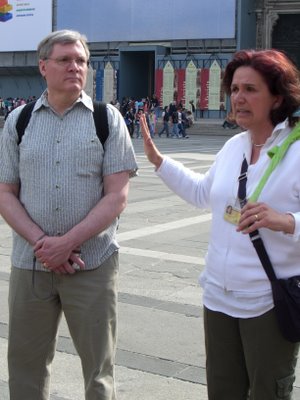Duke, duke, duke of....Milan, Milan Milan.

Above: What is distracting Sandi and Ljiljana? It was early and there were few other people in the square at that hour.
Our first full day in Italy took us to Milan's Piazza del Duomo. (Aaaaaargh!! Get those bloody pigeons off me!!) Between the ornate cathedral and the statue of Italy's king Vittorio Emmanuele, our guide for the day, Marica, gave us a primer on the city's complicated list of rulers. She pulled people from the crowd to stand in for Milanese dukes, Austrian princesses, French kings and the like, as she narrated. She had to use almost every person in the large group to get through the presentation!
Above: Marica picks Blaine to represent the first Duke of Milan.
Prada purse slung over her shoulder, Marica told us (in a wonderful Cockney accent with German and Italian inflections!) Milan was first ruled by lords from the house of Della Torre, then the lords of the house of Visconti.
To the best of my memory, the tenth Visconti ruler gave himself the ducal title, making him to Duke of Milan #1.
The son who became Duke #2 continued a legacy of cruelty, for which he was assassinated.
His brother became Duke #3. This guy had no sons, so hired a mercernary for battlefield duty. He was happy to have a good warrior on staff, and to make sure this soldier didn't freelance with other states, #3 offered his six-year old daughter in marriage. Never mind that this soldier, Francesco, was 24 years older than the child. Never mind that Francesco was already married.
To cut a long story short: #3 dies, last of his line. Buh-bye, Viscontis. Francesco marries the child, becomes Duke #4 and establishes his own dynasty. Hello, Sforzas. Your name will always be associated with Milan, and the castle Francesco builds, bearing your name, will be one of the city's best-known landmarks, the Castello Sforzesco.
And thus begins the Ambrosian Republic (named for the city's patron saint.)
Francesco's son in Duke #5. We think he poisoned his mother, a pretty tough chick who kept her finger in Milanese politics. He's nasty. He's assassinated.
The title goes to his 7-year old brother. Duke #6 obviously isn't ready for ducal duty, so his uncle does the job. #6 mysteriously dies from poisoning (oh, the rumor mill had quite a workout that year!)....
And Uncle Lodovico becomes Duke #7. He loses Milan to the French!! Then the Swiss get involved, Milan goes back to #7 - briefly. Then it goes back to the French. Then it goes to Lodovico's son....
Maximilian Sforza is Duke #8.
Thereafter, it was French rule, Spanish rule, Austrian rule, rule by the Holy Roman Empire - not necessarily in that order.
The only reason I remember as much of the history lesson as I do, was because of Marica's very lively and informed presentation - in three languages. Since our group was combined with two other groups for the morning, there were Spanish, German and English speakers, and Marica repeated each chapter effortlessly in each of those languages.
Coming from Milan with its rich multi-cultural heritage, it's no wonder its citizens, such as Marica are such accomplished multi-linguists! Arianna, also a Milanesa, speaks English, French, Spanish and Swedish, and the Milanese dialect.
Milan's colorful political history stablized (at least temporarily) under the reign of King Vittorio Emanuel II, who united Italy.
This statue of Vittorio Emanuele (Aaaaaargh!! Get those bloody pigeons off me!!) is one of the main features of the Piazza del Duomo, and the incredible Galleria that links the Duomo and La Scala piazze is also named for him.
Here are links to my earlier Milan posts:
The Duomo and Galleria
Saturday afternoon in the Piazza del Duomo
On the roof of the Duomo
Gillian Coldsnow
No comments:
Post a Comment